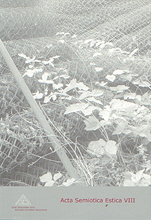Hegemooniline tähistamine visuaalretoorika perspektiivist
Hegemony as a visual rhetorical signification
Author(s): Andreas VentselSubject(s): Semiotics / Semiology
Published by: Eesti Semiootika Selts
Keywords: visual rhetorics; photography; hegemony; cultural semiotics; "socialist content; national form"; visuaalretoorika; fotograafia; hegemoonia; kultuurisemiootika; "sotsialistlik sisu; rahvuslik vorm"
Summary/Abstract: The present paper tackles the questions that can be briefly formulated as follows: 1) how to visualise power? and 2) does rhetorics have anything to offer to research on the visualisation processes of power? The paper discusses the relationship between the theory of hegemony as elaborated by Ernesto Laclau and the semiotics of culture of Juri Lotman and possibilities to use rhetoric to describe power relations in picture producing regime in society. The ground for believing this incorporation to be successful is the very apparent theoretical congeniality between them. They both belong to the Saussurean ontological terrain. The main functions that Lotman attributes to semiosphere bare the same functional roles as do Laclau’s central categories when he specifies his notion of discourse. Laclau’s discourse has quite the same attributions as Lotman’s text or semiosphere; Laclau’s “empty signifier” is similar to Lotman’s concept of block of contingent equivalences, metaphorogenous device that makes possible operations of translation in the conditions of untranslatability. They both think that the creation of meaningful totality (text, discourse) can only be figural or tropological construction – not a literal recognition or not only through one language. For Laclau, hegemony is to be understood only on the terrain of discourse: a hegemonic relation is a certain articulation of meanings. Laclau’s background concerning the problem of power and hegemony takes further the Foucaultian notion of positive aspect of power. According to Foucault power does not only say “no” but it also creates knowledge and produces meaningful discourses. One of these instruments through which power relations are established in society is photography. Using as an example the Soviet totalitarian society I show how concept of rhetoric help to clarify this process of hegemonic signification.
Journal: Acta Semiotica Estica
- Issue Year: 2011
- Issue No: 8
- Page Range: 026-050
- Page Count: 25
- Language: Estonian

